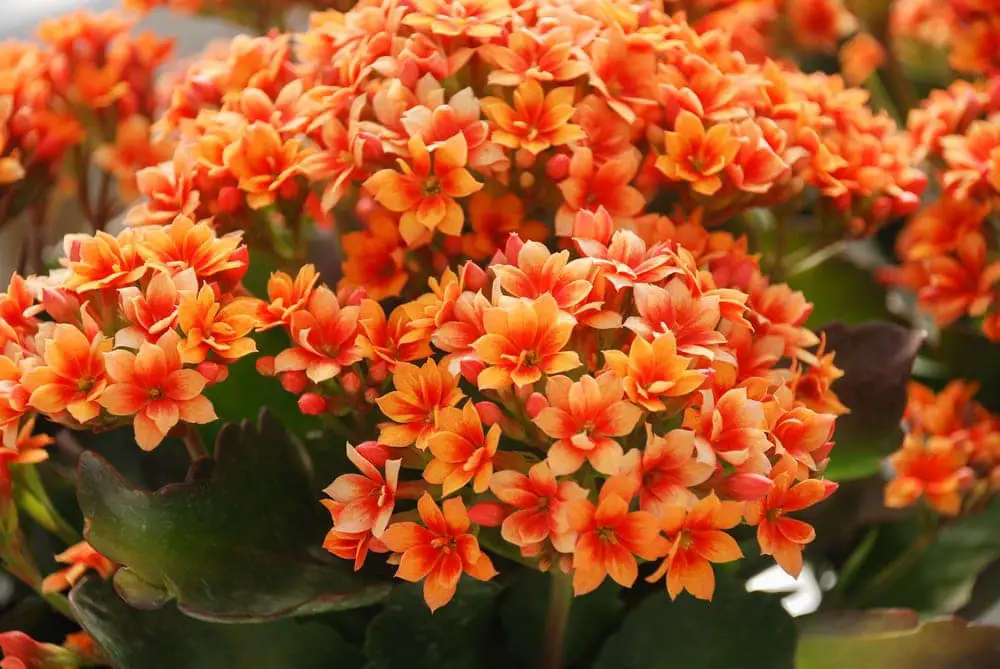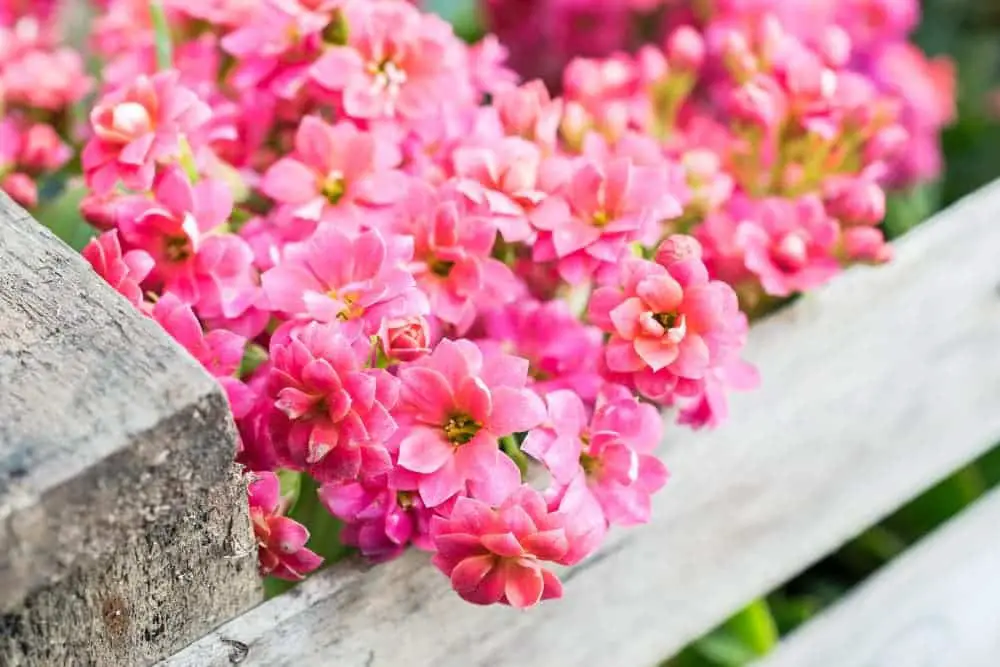This is the perfect flowering succulent to have in your home or office. It is a plant that produces colorful flowers and thrives on neglect.
This does not mean that you can forget to water them but they can go longer than other plants without water.
Flowering Kalanchoe Plant Care and Growing Guide
1. About The Flowering Kalanchoe Plant
This is a plant that you normally see around the holidays. It is a member of the genus Kalanchoe, which includes more than one hundred species. There are only a few of these species that are cultivated. They are native to arid areas. They are a relative of the Jade plant.
2. Light Requirement
This plant prefers bright sunny locations. This is especially true during the growing season. Have them in a south-facing window during the winter. It likes to receive natural sunlight but it cannot handle too much because it can cause the leaves to burn. This is especially true for the afternoon sun so give it the morning sun.
3. Water
This is a plant that requires a moderate amount of water but during the winter months, it will need even less. Let the soil become dry before you add more water. It is a plant that can by being watered only once every two weeks. In the fall and winter, you may only have to water your plant every six to eight weeks.
Drench your plant until the water runs out the drainage holes and then stop. This allows the roots to become hydrated. To irrigate your plant correctly, your Flowering Kalanchoe soil should be 50% dry. To tell if it is dry, poke your finger about two inches into the dirt to see if it is dry. If so, then water the plant.
4. Climate
Hardy zones 10-11 but if you are growing the plant indoors, it can be grown in any zone.
Learn more: Cat’s Claw Plant Care and Growing Guide
5. Soil
When planting these plants you can use a regular all-purpose fertilize mixed with perliter or combine it with a cactus mix. It needs to be a well-draining soil because you do not want the plant to get over-watered.
In addition to the right potting mix, you can also add in some other soil amendments to help with improving drainage for the plant. These can include coarse horticultural sand, bark chips, or charcoal pieces. If you do not have the right potting mix and adequate drainage, your plant can become diseased and rotten from sitting in soil that is too damp.

6. Fertilizer
Because they are a self-sufficient plant, you do not need to regularly feed your plant during the year. If you are fertilizing your plant during the growing season it is suggested that you use a balanced 20-20-20 fertilizer that is diluted according the instructions of the manufacturer. To help avoid root burn and a buildup of mineral salts, you should flush the soil every so often. During the fall and winter, you should never apply fertilizer.
7. Temperature and Humidity
This is a succulent that likes warmer temperatures. It has been found that the warmer the temperatures the fuller the blooms will be. The perfect temperature for a Flowering Kalanchoe plant indoors would be 60-85 degrees Fahrenheit. The minimum temperature your plant can stand is 40 degrees Fahrenheit. This plant needs to grow in a low humidity environment so you will never need to mist this plant.
8. Speed of Growth
The Flowering Kalanchoe plant is a slow-growing succulent.
9. Height and Spread
When grown indoors in a container, they can grow up to 18 inches with a spread of 20 inches. There are some that can be smaller with a height of 12 inches and a spread of four inches.
10. Flowers
The flowers of the Flowering Kalanchoe plant are not like most winter-blooming plants. It has blooms that are pink, yellow, red, and white. These plants bloom in response to the length of daylight the Flowering Kalanchoe gets. This means that you can get them to bloom even during the darkest winter days.
They are a perennial plant that will flower year after year. They naturally produce a lot of small flowers in the spring and can bloom up to six months. If you snip off the flowers after they fade, they will come back next year.

11. Propagation
The Flowering Kalanchoe plant can be propagated by using leaf cutting or tips. At the beginning of the growing season, cut off a section of a leaf that is a few inches long. Replant it in warm, moist soil. Make a small greenhouse by covering the cuttings with a plastic bag. This will increase their chances of rooting plus maintaining moisture.
Keep reading: Syngonium: Plant Care and Growing Guide
12. Trimming
To help your Flowering Kalanchoe plant grow fuller and to make sure that it comes back each year, you need to pinch off the dead flower stalks. You should do this in the spring after it is done flowering. Snip off the flower stalks near the base of the stems. You should also cut back any leggy growth that you see. This will help promote healthy plant growth.
13. Repotting
It does not need to be repotted often. When you are putting it in a larger pot, gently easy the root ball from the container and shake off excess dirt. Rinse the roots and check for root rot. Once this is done, you are ready to repot it in a new container with the right potting mix.
Is the Flowering Kalanchoe Plant Poisonous?
Yes, this plant is poisonous to children and pets.
More like this: Eugenia Topiary: Plant Care & Growing Guide
Common Flowering Kalanchoe Plant Diseases
- Over-watering: Root Rot
- Too much light: The Flowering Kalanchoe does not bloom the following year or will not produce flowers.
- High humidity: This can cause leaf spot or powdery mildew.
Conclusion
The Flowering Kalanchoe plant is photoperiodic, which means that they will flower depending on the length of the day. This is an easy succulent to take care of and all you need to do is make sure it has the right light, water, and potting mix to grow and flower every year.
Also read:
- Pothos vs Philodendron – How to tell the difference
- Corn Plant (Mass Cane) Care & Growing Guide
- Gladiolus: Plant Care
Victoria is the owner and main author of hobby plants. She loves spending her free time in her garden planting and taking care of her plants. Victoria hopes you enjoy the content here!




![Mother Of Thousands Plant [Complete Plant Care Guide] Mother Of Thousands Plant [Complete Plant Care Guide]](https://www.hobbyplants.com/wp-content/uploads/2022/07/mother-of-thousands-plant-300x158.jpg)
![Majesty Palm Plant Care: [Complete Beginner's Guide] Majesty Palm Plant Care: [Complete Beginner's Guide]](https://www.hobbyplants.com/wp-content/uploads/2022/08/majesty-palm-care-300x158.jpg)
![Exotic Angel Plant Care: [Complete Beginner's Guide] Exotic Angel Plant Care: [Complete Beginner's Guide]](https://www.hobbyplants.com/wp-content/uploads/2022/08/exotic-angel-plant-care-300x158.jpg)
![Snow White Waffle Plant: [Complete Care Guide] Snow White Waffle Plant: [Complete Care Guide]](https://www.hobbyplants.com/wp-content/uploads/2022/08/snow-white-waffle-plant-300x158.jpg)
![Waffle Plant Care: [Complete Beginner's Guide] Waffle Plant Care: [Complete Beginner's Guide]](https://www.hobbyplants.com/wp-content/uploads/2022/08/waffle-plant-300x158.jpg)
![Bird Of Paradise Plant Care: [Complete Beginner's Guide] Bird Of Paradise Plant Care: [Complete Beginner's Guide]](https://www.hobbyplants.com/wp-content/uploads/2022/08/bird-of-paradise-plant-300x158.jpg)
![Purple Passion Plant Care: [Complete Beginner's Guide] Purple Passion Plant Care: [Complete Beginner's Guide]](https://www.hobbyplants.com/wp-content/uploads/2022/08/purple-passion-plant-care-300x158.jpg)
![China Doll Plant Care: [Complete Beginner's Guide] China Doll Plant Care: [Complete Beginner's Guide]](https://www.hobbyplants.com/wp-content/uploads/2022/09/china-doll-plant-care-300x158.jpg)